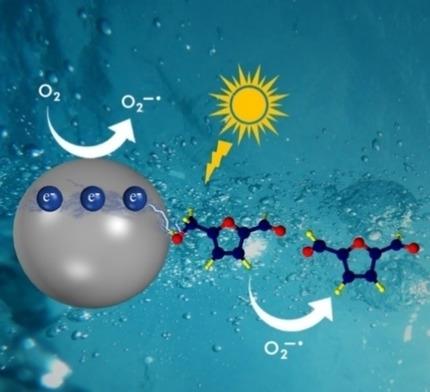当前位置:
X-MOL 学术
›
ChemSusChem
›
论文详情
Our official English website, www.x-mol.net, welcomes your
feedback! (Note: you will need to create a separate account there.)
Selective Oxidation of 5‐Hydroxymethylfurfural to 2,5‐Diformylfuran by Visible Light‐Driven Photocatalysis over In Situ Substrate‐Sensitized Titania
ChemSusChem ( IF 7.5 ) Pub Date : 2021-01-16 , DOI: 10.1002/cssc.202002687 Ayesha Khan 1 , Michael Goepel 2 , Adam Kubas 1 , Dariusz Łomot 1 , Wojciech Lisowski 1 , Dmytro Lisovytskiy 1 , Ariadna Nowicka 1 , Juan Carlos Colmenares 1 , Roger Gläser 2
ChemSusChem ( IF 7.5 ) Pub Date : 2021-01-16 , DOI: 10.1002/cssc.202002687 Ayesha Khan 1 , Michael Goepel 2 , Adam Kubas 1 , Dariusz Łomot 1 , Wojciech Lisowski 1 , Dmytro Lisovytskiy 1 , Ariadna Nowicka 1 , Juan Carlos Colmenares 1 , Roger Gläser 2
Affiliation

|
Solar energy‐driven processes for biomass valorization are priority for the growing industrialized society. To address this challenge, efficient visible light‐active photocatalyst for the selective oxidation of biomass‐derived platform chemical is highly desirable. Herein, selective oxidation of 5‐hydroxymethylfurfural (HMF) to 2,5‐diformylfuran (DFF) was achieved by visible light‐driven photocatalysis over titania. Pristine titania is photocatalytically inactive under visible light, so an unconventional approach was employed for the visible light (λ=515 nm) sensitization of titania via a formation of a visible light‐absorbing complex of HMF (substrate) on the titania surface. Surface‐complexation of HMF on titania mediated ligand‐to‐metal charge transfer (LMCT) under visible light, which efficiently catalyzed the oxidation of HMF to DFF. A high DFF selectivity of 87 % was achieved with 59 % HMF conversion after 4 h of illumination. The apparent quantum yield obtained for DFF production was calculated to be 6.3 %. It was proposed that the dissociative interaction of hydroxyl groups of HMF and the titania surface is responsible for the surface‐complex formation. When the hydroxyl groups of titania were modified via surface‐fluorination or calcination the oxidation of HMF was inhibited under visible light, signifying that hydroxyl groups are decisive for photocatalytic activity.
中文翻译:

原位基质敏化二氧化钛上可见光驱动光催化将 5-羟甲基糠醛选择性氧化为 2,5-二甲酰呋喃
太阳能驱动的生物质增值过程是不断发展的工业化社会的首要任务。为了应对这一挑战,非常需要有效的可见光活性光催化剂来选择性氧化生物质衍生的平台化学品。在此,通过二氧化钛的可见光驱动光催化实现了 5-羟甲基糠醛(HMF)选择性氧化为 2,5-二甲酰呋喃(DFF)。原始二氧化钛在可见光下不具有光催化活性,因此采用了一种非常规方法,通过在二氧化钛表面形成可见光吸收的 HMF(底物)复合物来实现二氧化钛的可见光( λ =515 nm)敏化。可见光下 HMF 在二氧化钛介导的配体到金属电荷转移(LMCT)上的表面络合,有效催化 HMF 氧化为 DFF。光照 4 小时后,DFF 选择性达到 87%,HMF 转化率为 59%。DFF 生产获得的表观量子产率为 6.3%。有人提出,HMF 的羟基与二氧化钛表面的解离相互作用是表面复合物形成的原因。当二氧化钛的羟基通过表面氟化或煅烧进行修饰时,HMF的氧化在可见光下受到抑制,这表明羟基对光催化活性起决定性作用。
更新日期:2021-03-07
中文翻译:

原位基质敏化二氧化钛上可见光驱动光催化将 5-羟甲基糠醛选择性氧化为 2,5-二甲酰呋喃
太阳能驱动的生物质增值过程是不断发展的工业化社会的首要任务。为了应对这一挑战,非常需要有效的可见光活性光催化剂来选择性氧化生物质衍生的平台化学品。在此,通过二氧化钛的可见光驱动光催化实现了 5-羟甲基糠醛(HMF)选择性氧化为 2,5-二甲酰呋喃(DFF)。原始二氧化钛在可见光下不具有光催化活性,因此采用了一种非常规方法,通过在二氧化钛表面形成可见光吸收的 HMF(底物)复合物来实现二氧化钛的可见光( λ =515 nm)敏化。可见光下 HMF 在二氧化钛介导的配体到金属电荷转移(LMCT)上的表面络合,有效催化 HMF 氧化为 DFF。光照 4 小时后,DFF 选择性达到 87%,HMF 转化率为 59%。DFF 生产获得的表观量子产率为 6.3%。有人提出,HMF 的羟基与二氧化钛表面的解离相互作用是表面复合物形成的原因。当二氧化钛的羟基通过表面氟化或煅烧进行修饰时,HMF的氧化在可见光下受到抑制,这表明羟基对光催化活性起决定性作用。











































 京公网安备 11010802027423号
京公网安备 11010802027423号